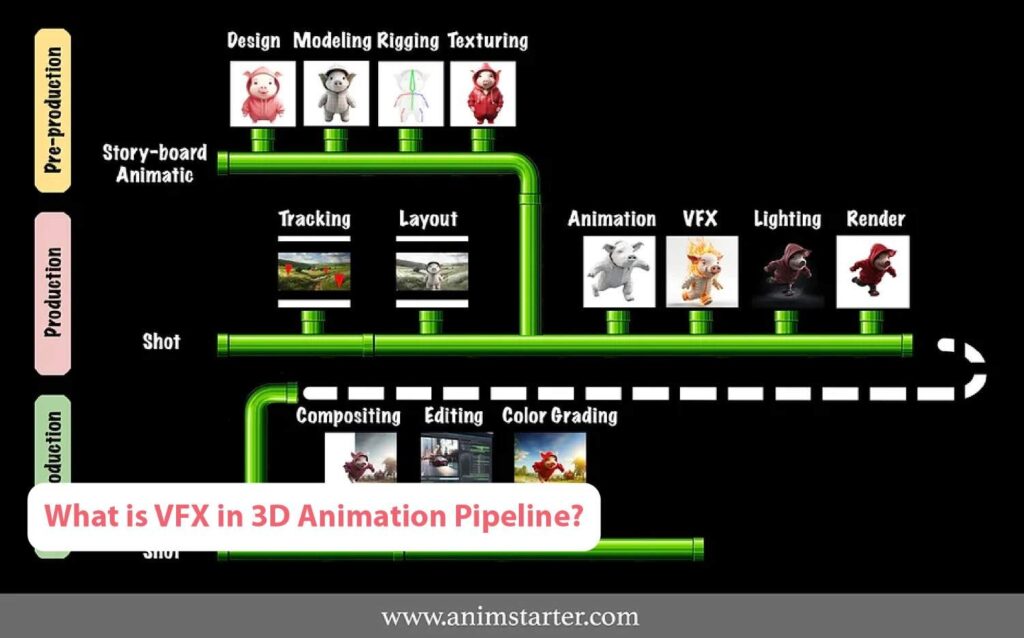
Visual effects, or VFX, are more than just digital wizardry—they’re a crucial part of the modern animation workflow. As we venture further into 2025, VFX has become deeply integrated into the 3D animation pipeline, elevating animated storytelling to new levels of realism and creativity. But what exactly is VFX in this context? How does it influence the production of animated films? And what tools and techniques are shaping the future of this vital craft?
In this comprehensive blog, we’ll answer all of these questions and more. We’ll explore the role of VFX in 3D animation pipeline, outline the key VFX techniques used in 3D animation, clarify the difference between VFX and CGI in animation, highlight the best VFX software for 3D animation, and walk through a step-by-step VFX workflow in 3D animation production. By the end, you’ll have a complete understanding of how VFX is transforming animation in 2025.
Defining VFX in the Context of 3D Animation
Visual effects (VFX) refer to the processes by which imagery is created, manipulated, or enhanced for film, television, or other visual media. In 3D animation, VFX enhances what is animated by adding elements such as explosions, water simulations, particles, light flares, environmental effects, and more.
It’s important to understand that VFX is not the animation itself—it’s the enhancement layer that builds upon base animation. While 3D animation handles modeling, rigging, and character movement, VFX handles the embellishment, realism, and visual spectacle that makes scenes unforgettable.
The Role of VFX in 3D Animation Pipeline
So, what is the exact role of VFX in 3D animation pipeline? Let’s break down its integration across different stages:
1. Pre-Production
In this phase, the VFX supervisor collaborates with the director and storyboard artists to plan shots that require visual effects. They assess the complexity of the desired effects, and help establish a pipeline to achieve them efficiently.
2. Production
During production, the primary animation and 3D modeling are created. The VFX team works closely with animators to prepare for the integration of effects such as smoke, fire, magic, water, wind, or background enhancements.
3. Post-Production
This is where the magic truly happens. Once core animation assets are in place, VFX artists bring scenes to life with particles, lighting effects, compositing, matte painting, and dynamics simulations. The results are layered into the final composition.
Without VFX, the 3D animation pipeline would lack depth and visual impact. VFX ensures the story feels immersive and visually compelling.
How VFX Enhances 3D Animated Films
From high-budget studio blockbusters to streaming service originals, visual effects play a defining role in creating iconic moments. Here’s how VFX enhances 3D animated films in 2025:
• Adds Realism
Advanced VFX tools simulate real-world physics—how water splashes, how light reflects, or how fire burns. This realism connects emotionally with audiences.
• Expands Creative Freedom
VFX empowers animators to go beyond the laws of nature. Want to create magical portals or worlds made of candy? VFX makes the impossible possible.
• Heightens Drama and Impact
VFX adds visual storytelling power. A simple moment like a character lighting a match can become cinematic with dynamic lighting and particles.
• Sets Mood and Atmosphere
From eerie fog to golden sunsets, VFX helps create moods that support storytelling tone and genre.
• Supports Dynamic Camera Work
With VFX, animators can craft complex sequences with simulated physics, motion blur, debris, and transitions that make shots feel alive.
Key VFX Techniques Used in 3D Animation
Let’s dive into the key VFX techniques used in 3D animation that have become mainstream in 2025:
1. Particle Systems
Used for effects like rain, fire, smoke, dust, sparkles, and abstract energy fields. Artists can simulate hundreds of thousands of particles with unique behaviors.
2. Fluid Simulations
Water, lava, slime, and other fluid effects are generated using real-world fluid dynamics engines.
3. Cloth and Hair Simulation
Used to animate clothing, hair, or soft-body dynamics based on motion and environmental forces.
4. Rigid Body and Soft Body Dynamics
Simulate physical interactions between solid objects (like crashing cars or collapsing buildings).
5. Volumetrics
Create clouds, fog, atmospheric lighting, and energy blasts by simulating volumetric lighting and density.
6. Compositing and Layering
Multiple renders are layered and color-corrected in post-production using compositing software to achieve the final image.
7. Matte Painting
Combines hand-painted or digitally created backgrounds with 3D environments.
8. Motion Tracking
Used when combining 3D elements with live-action footage, which is less common in full 3D films but useful for hybrid media.
Difference Between VFX and CGI in Animation
The difference between VFX and CGI in animation often causes confusion. Let’s clarify:
- CGI (Computer-Generated Imagery) is the umbrella term that includes all digital imagery—from 2D to 3D models, environments, and characters.
- VFX is a subset of CGI, applied specifically to enhancing visuals after or alongside the animation process.
In other words:
- CGI = creation of digital content (modeling, texturing, animating)
- VFX = integration and manipulation of those assets for cinematic effect
So while both use computers to create images, their purposes differ. VFX focuses on spectacle and polish, while CGI includes the groundwork of creating the 3D models and scenes.
Best VFX Software for 3D Animation
If you’re an animator or studio in 2025, what tools should you use? Here are the best VFX software for 3D animation:
1. Autodesk Maya
Still an industry leader in 2025, Maya integrates fluid simulation, dynamics, and VFX plug-ins, making it ideal for advanced VFX.
2. Houdini by SideFX
The gold standard for procedural VFX. Houdini’s node-based system is perfect for complex particle, destruction, and simulation effects.
3. Blender
The open-source powerhouse continues to evolve. Blender’s powerful VFX add-ons and simulation systems make it ideal for indie projects.
4. Adobe After Effects
Primarily for compositing, motion graphics, and integrating VFX layers.
5. Nuke by Foundry
A professional-level compositor used in studio VFX pipelines for assembling final scenes.
6. RealFlow
Used specifically for high-quality fluid simulations.
7. EmberGen
In 2025, EmberGen is a favorite for real-time smoke, fire, and volumetric effects previews.
8. Unreal Engine
While primarily a game engine, Unreal’s cinematic rendering and VFX capabilities make it a powerful tool for real-time animation workflows.
Step-by-Step VFX Workflow in 3D Animation
Let’s walk through a step-by-step VFX workflow in 3D animation. Each project is different, but this is the general structure followed by most professionals:
Step 1: Planning and Pre-Visualization
- Storyboards and animatics define scenes that require VFX.
- The VFX team identifies effect types (water, fire, particles) and collaborates with directors and animators.
Step 2: Asset Preparation
- 3D models, rigs, and base animation are created.
- These assets are handed off to the VFX team for enhancement.
Step 3: Simulation and Effects Creation
- Particle systems, dynamics, and simulations are generated.
- Artists test different parameters (e.g., wind direction, explosion timing).
Step 4: Lighting and Rendering
- Simulated VFX are lit to match the base scene.
- Multiple render passes (diffuse, specular, shadows, etc.) are created.
Step 5: Compositing
- VFX passes are layered and adjusted using compositing software like After Effects or Nuke.
- Color grading and final tweaks are applied.
Step 6: Integration and Review
- Effects are integrated into final animation scenes.
- Supervisors review the timing, realism, and performance.
- Final renders are exported.
The complexity of each step depends on the scale of the animation. Large studios have dedicated departments for simulation, lighting, and compositing.
Future of VFX in 3D Animation
VFX continues to evolve rapidly, especially with AI integration and real-time rendering. In 2025, expect these emerging trends:
• AI-Powered Simulation
AI is optimizing simulations, making cloth, fluid, and destruction physics easier to create with fewer iterations.
• Real-Time VFX Editing
With tools like Unreal Engine 5, creators can tweak VFX in real time, reducing feedback loops.
• Procedural Workflows
Proceduralism via tools like Houdini enables scalable, reusable effects systems.
• Cloud-Based Collaboration
Studios collaborate globally on shared VFX shots in real-time cloud environments.
• Hybrid Techniques
The line between VFX, animation, and live-action continues to blur. We’re seeing more stylized and hybrid visual approaches.
Final Thoughts
In 2025, VFX in 3D animation is no longer an optional add-on—it’s a cornerstone of high-quality production. The role of VFX in 3D animation pipeline involves elevating basic animation into cinematic spectacle. With the right tools and techniques, VFX artists create unforgettable visual moments that enhance story, mood, and realism.
Whether you’re an aspiring VFX artist, a professional animator, or a creative director, mastering visual effects is essential in today’s industry. From understanding the difference between VFX and CGI in animation, using the best VFX software for 3D animation, and learning the step-by-step VFX workflow in 3D animation, your journey in visual storytelling starts here.
Frequently Asked Questions (FAQ’s)
What is VFX in 3D animation?
VFX, or visual effects, involves creating digital effects such as explosions, fire, smoke, and water simulations using computer-generated imagery (CGI). This technique enhances visual storytelling by adding elements that are difficult or impossible to film in real life. VFX artists use sophisticated software to create these effects, making them blend seamlessly with live-action or animated scenes to create immersive experiences.
How does VFX fit into the 3D animation pipeline?
In the 3D animation pipeline, VFX comes into play after 3D models have been created, rigged, and animated. It involves adding visual enhancements and effects to the rendered animations, which are then integrated into live-action footage or other animated elements. This stage is crucial for finalizing the visual elements, ensuring that they align with the director’s vision and contribute to a cohesive and visually captivating final product.
What are the main categories of VFX in 3D animation?
VFX in 3D animation includes:
- Particle Simulation: Effects like dust, smoke, and fire that enhance realism.
- Fluid Simulation: Realistic rendering of liquids such as water and oil, adding natural movement and flow.
- Hair and Fur Simulation: Creating lifelike hair and fur dynamics, adding detail and realism to characters.
- Body Simulation: Encompassing rigid-body simulations for hard objects and soft-body simulations for flexible materials.
What software is commonly used for VFX in 3D animation?
Key VFX software includes:
- Autodesk Maya: Used for comprehensive 3D modeling, animation, and rendering.
- SideFX Houdini: Known for its powerful simulation and effects capabilities.
- Adobe After Effects: Ideal for compositing, color grading, and finalizing visual effects.
- Foundry Nuke: Specializes in integrating CGI with live-action footage through advanced compositing techniques.
- Autodesk 3ds Max: Offers tools for 3D asset creation and animation.
How has VFX changed the animation industry?
VFX has revolutionized the animation industry by enabling the creation of highly detailed and immersive visual effects that push the boundaries of creativity. It has made it possible to blend live-action with CGI seamlessly, reducing the need for expensive practical effects and physical sets. Additionally, VFX allows for more dynamic and intricate storytelling, transforming how audiences experience animated and live-action films.





